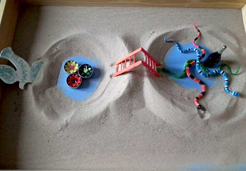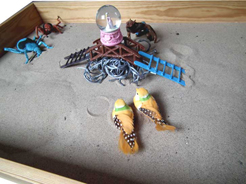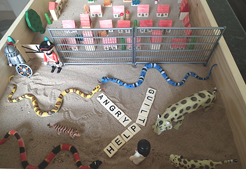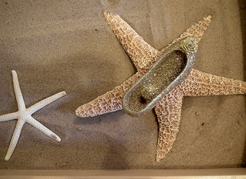Jungian Analysis Explained
In order to explore the various realms in which the materials of the unconscious reside, a trusting therapeutic alliance is first forged between analyst and patient. This collaborative relationship is based on mutual respect and a shared interest in exploring the personal unconscious through the images and patterns that arise in an individual's dreams, fantasies, memories, developmental history, creative expressions and the events of daily life. The relational dynamics which are experienced between analyst and patient are also considered to further inform how unconscious patterns and beliefs may be impacting the present here-and-now relationships of the patient.
Self awareness is also expanded by observing the concrete manifestations of the collective-unconscious (universal themes or archetypes which run through all human life) revealed in the archetypal stories, patterns and images found in mythology, fairy tales, and the arts, that mirror human behaviours and patterns and can be harnessed and used to support healing.
The ongoing focus on metaphorically plumbing the depths of the psyche gradually, over time, reveals the unconscious, un-lived and lesser known parts of our personalities, as well as illuminating the motives, passions, impulses, defenses, and insecurities at work within us. When this is combined with an increased awareness of the projections unconsciously made to others (both positive and negative projections) the new information can be used in the service of becoming a more conscious and fulfilled human being.
Jung described this inner process of self-realisation as ‘Individuation’, a life-long process through which a person becomes his or her true self by seeking wholeness rather than perfection. The latter part of this journey involves finding genuine meaning in life and, ultimately, in death and wrestling with these existential questions develops and expands one's knowledge of self. Although this suggests analysis is a courageous undertaking, requiring considerable commitment to stay with process of reflecting on the meaning of life, the analysis supports the development of a personal Temenos (Greek definition: land marked off as a sanctuary), a safe place for contemplation and honest reflection of life’s lived, felt, lost or longed for experiences.
This soul searching exploration is undertaken in the presence and support of your analyst who has a wealth of both personal and clinical experience of the unpredictable terrain of the psychological journey as well as the inner imaginal realm. Jungian Analyst is a protected title, reflecting both the analysts craft and the rigorous academic training underpinning the professional qualification. What separates Jungian Analysis from other purely academic programmes is the mandate that anyone in training to become a Jungian analyst, must first and foremost, wrestle with the material of his or her own life within the context of an extensive, personal, training analysis. This requirement ensures that analysts in training are maturing psychologically in tandem with their professional aspirations; that they participate first-hand in the rigors of a deep, emotional, intellectual, psychological and creative encounter with the unconscious in all its manifestations; and that they experience a growing awareness of the potential complications of their own blind spots and complexes as they work with patients.
Thus, before becoming a Jungian Analyst, a training candidate must complete a training analysis with an IAAP registered analyst comprising 3 x sessions per week over a minimum period of 4 years.
There are some psychotherapeutic techniques specifically developed from Jungian theory such as sandplay. Sandplay dates back to HG Wells’ observations of his two sons playing on the floor with miniature figures and his realisation that they were working out their problems with each other and other members of the family. Inspired by this paediatrician Margaret Lowenfeld introduced sandplay as a therapeutic art medium in the 1920’s developing a model that came to be known as the ‘World Technique’.
Participants choose from a whole range of miniature objects (small toys or little ornaments) which are supplied in categories such as people (including aggressive figures, loving figures, mythical figures and family figures); transport (including emergency services vehicles & a range of other modes); animals (monsters, farmyard, and jungle creatures); buildings (houses, prisons, castles etc); furniture (beds, baths, chairs etc); outside man made objects (roads, fences, signs etc) and outside natural world objects (trees, flowers, stones etc).
Unlike painting, the miniatures are easily moveable so the participant can rearrange them, try out different placings, adding things or taking things out, until they are entirely satisfied they have communicated an accurate version of their feelings. Through sandplay, the participant can convey multiple meanings and different aspects of the same experience simultaneously, which is particularly beneficial for trauma work where they is often conflicting or multiple feelings in response to an event.
Sandplay is especially useful for conveying the feeling tone of a participants inner world with exactitude due to the complex relation of forms, moulding and shaping of the sand, the choice of miniatures in terms of size, symbol, colour and their positioning and placing, distance from each other, height and depth.
Dora Kalff, a Zurich based Jungian later came to London to study the technique with Lowenfeld and recognised that allowing all kinds of expression it specifically encouraged and provided for the process of individuation, an important Jungian concept by which the self is formed by integrating elements of the conscious and unconscious mind. Subsequently symbolic play was recognised as one of the most important ingredients in accessing natural wisdom and promoting healing through images. Sandplay is now established as a truly integrative approach of art therapy as well as Jungian analysis and is used widely with adults, not just children.



